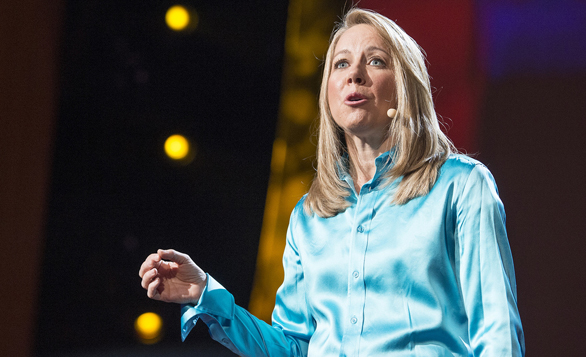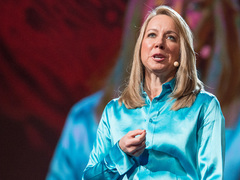
Meg Jay gave a talk at TED2013 suggesting that the 20s are a person’s defining decade — and it started a heated debate at the office. Here, a 20-something responds. Photo: James Duncan Davidson
I’m 24 and a woman, and that makes me a target for a lot of speculation and life advice. Sheryl Sandberg wants me to lean in to become a woman leader; Anne-Marie Slaughter says my lady parts may doom me to a half-fulfilled life; Susan Patton thinks I should have spent my time at Princeton looking for a husband (ideally one of her sons); and in TIME Magazine’s most recent cover story, Joel Stein suggests that I’m narcissistic and dying to be famous. Everyone’s talking about me.
And people wonder why millennials are so self-involved.
 Meg Jay: Why 30 is not the new 20
Now I can add clinical psychologist Meg Jay, who gave today’s talk, to the list of well-intentioned non-millennial millennial critics. Jay spoke at TED2013 — and emphatically stated that “30 is not the new 20.” She urges twentysomethings to rid themselves of the idea that their 20s are a prolonged adolescence, throwaway years. According to Jay, 80 percent of life’s defining moments happen by the time a person is 35. Powerful — and intimidating — words.
Meg Jay: Why 30 is not the new 20
Now I can add clinical psychologist Meg Jay, who gave today’s talk, to the list of well-intentioned non-millennial millennial critics. Jay spoke at TED2013 — and emphatically stated that “30 is not the new 20.” She urges twentysomethings to rid themselves of the idea that their 20s are a prolonged adolescence, throwaway years. According to Jay, 80 percent of life’s defining moments happen by the time a person is 35. Powerful — and intimidating — words.
To be honest: When I first heard the talk, I was appalled. It wasn’t a message I wanted my peers to hear: it put pressure on an already overstimulated generation to find the right career and start thinking about marriage now. And it seemed to simultaneously berate thirtysomethings, telling them their most important years were over and it was too late to get what they wanted.
In her book, The Defining Decade: Why Your Twenties Matter – and How to Make the Most of Them Now, Jay addresses a lot of the eyebrow-raisers she couldn’t in her 14-minute talk. As anybody who has given a TED or TEDx Talk knows: Boiling years of work down to 18 minutes is a terrifying honor. While the format makes for a good introduction to a new idea, the nuance and detail can be lost in the condensation. The heteronormative lifestyle Jay seems to take for granted in her talk is subdued in her book, which actually dedicates its first 30 percent to work. And the book very quickly establishes a critical condition that’s taken for an assumption in her talk: That her advice is geared toward people who choose to list marriage and/or children in their life goals.
In her book, Jay includes personal experiences and reflections that help to soften what could otherwise seem like a condescending stance. She writes, “Like many twentysomethings, I wanted to establish my career before I had kids, and I did. I waddled across the stage to collect my Ph.D. diploma while eight months pregnant with baby number one.” By the time she had her second child Jay had a university job. But she writes, “Having two babies after thirty-five did not go quite as smoothly as I expected, and now I see how lucky I was. Many women are not as fortunate.” Jay wants twentysomething readers to avoid some of the same mistakes she feels she might have made.
If you are in your 20s and marriage and/or children are things you desire, Jay has a lot to say on the matter. She opposes the media’s portrayal of American twentysomethings as a “culture dominated by singles who are almost obsessed with avoiding commitment.” She writes, “I have yet to meet a twentysomething who doesn’t want to get married or at least find a committed relationship.” The anecdote doesn’t convince me, but Jay’s argument that postponing marriage just for the sake of it is a reasonable one. Just because people get married later doesn’t mean that, a priori, later is better. And that also doesn’t mean twentysomethings should be content to date and cohabitate for years with people they know they won’t end up with. At least thinking about the qualities you want in a long-term partner while you’re in your twenties, says Jay, can help prevent what she sees often in her practice: people who rush into marriage when they turn thirty because it’s suddenly the time to care. Basically: Start worrying in your twenties, and you might not feel as screwed in your thirties.
Twentysomething women trying to figure out how to have it all will have to look elsewhere. In her chapters on work and love, Jay doesn’t address the critical relationship between the two — and more important, how one might hinder the other. She doesn’t recognize that for an ambitious twentysomething, there simply might not be enough hours in the day to further a career and work on finding the perfect mate.
Ultimately, Jay’s goal is to create a sense of urgency for twentysomethings so they don’t end up in their 30s feeling like they wasted the past ten years — and to provide tools to deal with this proverbial fire under the butt. As she told me, “I’m being sincere when I say there’s nothing worse than sitting across from a 35-year-old who’s realizing they’re never going to get the life they want, and that’s sad. Creating urgency for twentysomethings is okay.” But how this helps anyone over thirty is less clear.
Indeed, Jay’s book could be a pretty depressing read for thirtysomethings who haven’t been powerwalking through their 20s. It might also add more pressure to twentysomethings who are being told from every angle what their generation could be doing better. It’s nice to imagine a bunch of Gen X’ers sitting around nodding their heads saying “Yes, yes, yes I wish I had heard this when I was 20. Onward, millennials! Succeed where we failed!” Certainly these people exist, as evidenced by the deluge of Gen X advice to young poets (Jay, Sandberg, Slaughter and Stein are all Gen X’ers); but what’s much more likely is a bunch of thirtysomething women tearing their hair out when they are told that being the first real beneficiaries of feminism and birth control has doomed them to spinsterhood.
And finally: What about youth? If your 20s is not the time to have fun, when is? As Jay says in her talk, “I’m not discounting twentysomething exploration here, but I am discounting exploration that’s not supposed to count. Which by the way, is not exploration. That’s procrastination.”
I’m not going to upend modern philosophical thought when I say: Not all experiences need a focus, and not everything that counts can be counted. While I had hoped that Jay’s final chapter, “The Brain and the Body,” would focus on the sort of “capital” that doesn’t belong on a work or relationship résumé, it turned out to be further reading on my developing adult brain and my rapidly deteriorating eggs. Adults need to play, too.
When I asked Jay about “fun,” she said “there should be fun all throughout your life. Twentysomethings shouldn’t feel this pressure to live their life like an eternal spring break — because how can it, when you’re working and you don’t have money and you don’t know whether you’re going to get a text back from the person you like? It’s actually a very stressful time.” Agreed, but — as you get older — spring break gets harder and harder to schedule. While Jay finds it hard to see what is fun about scrambling for the L train at 4 am after too much Scotch, it’s hard for me to imagine what’s fun about owning a home and having two kids. And, yes, I know that’s in part because I’m in my twenties.
If my father’s house had a mantra, it would be “Life is long.” I was infused with the belief that I could do anything I wanted, at any age. No one likes thinking about life as a series of limitations, and certainly no woman likes to think of herself as a ticking time bomb. But Jay is right when she says we all have to face certain realities: Time runs out. Which is why I am also completely on board with Jay’s own mantra: Be intentional. Because while we may have different ideas on how to live the good life, Jay and I can agree that the intention of living it should be realized early and often.
Comments (15)
Pingback: American Steroids Online
Pingback: Thoughts From a 20-something | Mrs.Gapper's Notes
Pingback: "30 Is Not the New 20": 3 Things Every 20-Something Needs to Hear | Intent BlogIntent Blog
Pingback: Friday Night Links 17 May 2013 | Princess Revolver Productions